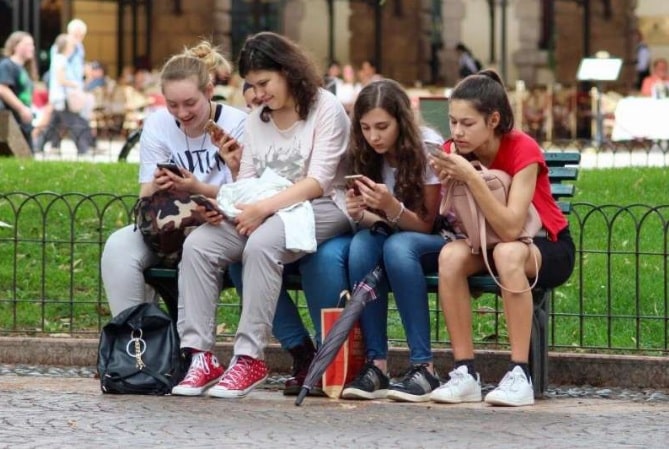Researchers showed long ago that artificial intelligence models could identify a person’s basic psychological traits from their digital footprints in social media.
That may be just a start. A new study, co-authored by Stanford’s Johannes Eichstaedt and Aaron Weidman (University of Michigan), provides strong evidence that machine-learning models can also map a person’s mood swings and volatility from week to week.
Using natural language processing tools to analyze Facebook posts, the new machine-learning model infers both how happy or sad a person is feeling at any given time as well as how aroused or lackadaisical. Over time, this algorithm can even produce a video out of a person’s emotional ups and downs.
The findings could spark new worries about privacy or the use of social media to market to people. In theory, marketers or political propogandists could someday tailor their messages based on which message elicits the strongest emotional reaction.
But Eichstaedt, a Stanford Humanities & Sciences assistant professor of psychology and a faculty fellow at the Stanford Institute for Human-Centered Artificial Intelligence, says the approach could help diagnose people with mood disorders and see how well they respond to a medication, therapy, or a change in lifestyle.
“If this kind of approach is used ethically and legally, with strict privacy protection, we could someday have ways to computationally understand the mind,” Eichstaedt says. “It could help with diagnosis and pharmaceutical evaluation. It could also help us track the psychological impact of traumatic societal events, such as the COVID pandemic.”
For the moment, both the good and bad possibilities are still well in the future. For one thing, the results are preliminary, based on a small number of mostly American Facebook super-users who posted much more often than most people. As a result, the researchers caution, the results may not be representative of all Americans. They may be even less representative of people from other cultures.
That said, the researcher noted, the machine-learning program offered tantalizing evidence that it was on the right track. In fact, many of the mood patterns that it found were consistent with previous studies by other researchers that were based on people self-reporting their own feelings.
Training Machines To Track Feelings
Eichstaedt and Weidman began by having human research assistants annotate public Facebook postings of nearly 3,000 volunteers from an earlier study. The research assistants rated each post on its “valence”—how much it expressed positive or negative emotions—and on “arousal”— or the intensity of those feelings.
Once those ratings were complete, the posts were used to train a machine-learning model that would predict which kinds of language conveyed which kinds of feelings. Eichstaedt and Weidman then tested their model on an entirely different set of posts from 640 heavy Facebook users. People in this second group posted an average of 17 times a week over 28 weeks. This produced a (now public) dataset tracking emotional dynamics across 18,000 person-weeks—the largest dataset on weekly emotional dynamics ever compiled, which is available for mining by the research community.
Evaluating the Model
To get some sense of whether the machine-learning model was reading people right, Eichstaedt and Weidman looked at how well the patterns it revealed matched up with the predictions based on classical in-person psychological studies.
The results lined up with predictions based on a list of what psychology researchers call the “Big Five” personality traits—openness, agreeableness, extroversion, conscientiousness, and neuroticism. All the Facebook users in the study had volunteered to participate in a “My Personality” study, which measured the Big Five traits through a questionnaire. Consistent with the earlier predictions, people whom the machine-learning model rated higher on extroversion, agreeableness, and conscientiousness tended to feel both more upbeat and more aroused.
As it happened, the machine-learning results also neatly dovetailed with earlier studies about the relationship between how good people feel and how aroused they are at any given moment. Just as the earlier studies had theorized, the machine-learning results showed a lop-sided “V-shaped” relationship: Arousal goes up both as people feel more up and more down, but the relationship was stronger for the upbeat emotions; it’s hard to feel something very positive without also feeling upbeat.
Gender Discrepancies
The researchers also found that men and women showed somewhat different emotional patterns.
The women tended to be somewhat more upbeat than men and to have a wider emotional “resting point,” or typical level of pleasant and/or aroused feelings. Put another way, says Eichstaedt, men tend to be grumpier and less emotionally responsive to their environment than women. That’s consistent, says Eichstaedt, with the idea that women have higher “emotional flexibility.”
Eichstaedt cautions that it’s too early to know whether machine learning could eventually provide the equivalent of an accurate MRI image for mood. But given all the data available on social media, he says, it could well open new opportunities for understanding human emotional dynamics at much larger scale.
Article: Researcher uses machine learning to identify mood swings through social media
